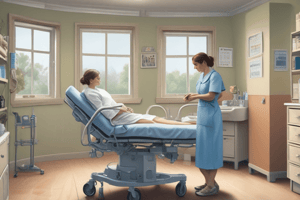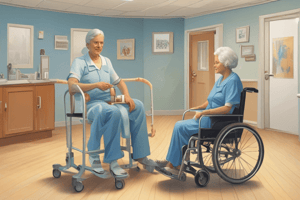Podcast
Questions and Answers
What is the primary reason why a patient may become particularly chilled in a hospital setting?
What is the primary reason why a patient may become particularly chilled in a hospital setting?
- Limited mobility and impaired circulation (correct)
- The use of cold therapy for pain management
- The effects of soap and detergents on the skin
- Exposure to drafts and cool temperatures
Which of the following factors is not considered a primary aspect of maintaining a therapeutic hospital room environment?
Which of the following factors is not considered a primary aspect of maintaining a therapeutic hospital room environment?
- Adequate lighting
- Room temperature
- Presence of a personal television (correct)
- Minimizing noise levels
What is the main reason behind the use of warm or hot water baths for patients?
What is the main reason behind the use of warm or hot water baths for patients?
- To relax muscles and promote circulation
- To cleanse and disinfect the skin in cases of infection
- To control fever and lower body temperature
- To provide a soothing experience and improve hygiene (correct)
Which of the following correctly describes the defining characteristic of Stage III pressure injury?
Which of the following correctly describes the defining characteristic of Stage III pressure injury?
Which of the following is LEAST likely to contribute to the development of a pressure injury?
Which of the following is LEAST likely to contribute to the development of a pressure injury?
In the context of patient care, what is the primary purpose of using cold therapy?
In the context of patient care, what is the primary purpose of using cold therapy?
Which of the following is NOT considered a component of basic patient hygiene?
Which of the following is NOT considered a component of basic patient hygiene?
What is the main contraindication for a back rub?
What is the main contraindication for a back rub?
Which of the following best describes the purpose of tepid sponge baths?
Which of the following best describes the purpose of tepid sponge baths?
Why is it important for nurses to be role models for personal hygiene?
Why is it important for nurses to be role models for personal hygiene?
When providing perineal care for a male patient, which of the following is the correct order of steps? Assume the patient is not circumcised.
When providing perineal care for a male patient, which of the following is the correct order of steps? Assume the patient is not circumcised.
Skin care assessment involves observing changes in skin characteristics. Which of these is NOT a relevant indicator for assessing skin health?
Skin care assessment involves observing changes in skin characteristics. Which of these is NOT a relevant indicator for assessing skin health?
When making an occupied bed, which technique is most important for ensuring patient safety?
When making an occupied bed, which technique is most important for ensuring patient safety?
Which of the following actions would NOT be considered appropriate when assisting a patient with a bedpan?
Which of the following actions would NOT be considered appropriate when assisting a patient with a bedpan?
Which of the following statements is MOST ACCURATE regarding the relationship between skin health and overall well-being?
Which of the following statements is MOST ACCURATE regarding the relationship between skin health and overall well-being?
Flashcards
What is perineal care?
What is perineal care?
Care of the external genitals (male or female). This might include cleaning, inspecting for any issues, and checking for signs of infection.
What is skin care?
What is skin care?
Washing and drying the skin, paying attention to areas prone to irritation. This might involve using lotion or soap.
What is an unoccupied bed?
What is an unoccupied bed?
Making a bed when the patient is not in it. This involves changing the sheets, making the bed neat and tidy, and ensuring it is comfortable for the patient.
What is an occupied bed?
What is an occupied bed?
Signup and view all the flashcards
What is assisting with elimination?
What is assisting with elimination?
Signup and view all the flashcards
What is a therapeutic hospital room environment?
What is a therapeutic hospital room environment?
Signup and view all the flashcards
What is personal hygiene?
What is personal hygiene?
Signup and view all the flashcards
How do bath procedures vary for patients?
How do bath procedures vary for patients?
Signup and view all the flashcards
What is a complete bed bath?
What is a complete bed bath?
Signup and view all the flashcards
What are pressure injuries?
What are pressure injuries?
Signup and view all the flashcards
How are pressure injuries prevented and treated?
How are pressure injuries prevented and treated?
Signup and view all the flashcards
What are heat and cold therapy applications?
What are heat and cold therapy applications?
Signup and view all the flashcards
What is oral hygiene?
What is oral hygiene?
Signup and view all the flashcards
What is a back rub?
What is a back rub?
Signup and view all the flashcards
What is hair care?
What is hair care?
Signup and view all the flashcards
Study Notes
Chapter 9: Hygiene and Care of the Patient's Environment
- This chapter covers hygiene and environmental care for patients.
- It discusses the therapeutic hospital room environment.
- It describes personal hygiene practices.
- It details variations in bath procedures based on patient condition and physician orders.
- It explains the procedure for a bed bath.
- It identifies nursing interventions for preventing and treating pressure ulcers.
- It discusses heat and cold therapy and related procedures.
- It describes procedures for oral hygiene, shaving, hair care, nail care, eye, ear, and nose care.
- It outlines the procedure for a back rub.
Patient's Room Environment
- Factors affecting the patient's environment include a comfortable and safe environment
- Important factors include temperature, ventilation, noise levels, odors, and lighting.
Life Span Considerations (Older Adults)
- Older adults may experience factors like becoming chilled, limited mobility, impaired circulation, and adverse effects of soaps and detergents on their skin when doing hygiene care.
Room Equipment
- Essential room equipment includes bedside stands, beds, overbed tables, chairs, and lights.
Hygiene
- Principles of health include holistic care encompassing skin, hair, hands, feet, eyes, ears, nose, mouth, back, and perineum.
- Personal hygiene consists of self-care measures to maintain health and prevent diseases.
- Nurses are vital role models and teachers demonstrating proper hygiene.
Bathing
- Often, unlicensed assistive personnel perform bathing tasks.
- Therapeutic baths include cool water tub baths, warm water tub baths, hot water tub baths, and sitz baths.
Other Baths
- Bath types include complete bed baths, partial assistance during bed baths, tepid sponge baths, and medicated baths.
Pressure Injuries
- Normal skin characteristics are important to consider
- Impaired skin integrity can lead to pressure injuries.
- Pressure injuries occur when persistent pressure on the skin causes blood vessel collapse.
- Factors influencing pressure injuries include shearing force and friction.
- Prevention and interventions for pressure injuries are essential.
Stages of Pressure Injuries
- Stage I: Localized skin area with nonblanchable redness.
- Stage II: Partial-thickness loss of dermis.
- Stage III: Full-thickness tissue loss, subcutaneous fat, tendon or muscle visible.
- Stage IV: Full-thickness tissue loss, exposed bone, tendon or muscle.
- Unstageable/unclassified Injuries involve full-thickness tissue loss with a wound base covered by eschar or slough
Heat and Cold Therapy
- Patients with injuries often benefit from heat or cold therapy application.
- Heat applications promote comfort and healing.
- Cold applications decrease swelling and pain.
- Heat and cold therapy can be applied in either dry or moist form.
Components of Patient's Hygiene
- This category includes; oral hygiene, hair care, shaving, hand, foot, and nail care, perineal care, and eye, ear, and nose care.
Back Care and Back Rubs
- Back care and related rubs are provided post-bathing.
- Back rubs promote relaxation, relieve muscle tension, and stimulate circulation.
- Understanding contraindications is crucial for safe back rubs.
Lesson 9.2: Further Hygiene and Care of the Patient's Environment
- This lesson continues the discussion of patient care.
- It covers procedures for perineal care (male and female).
- It discusses skin care procedures.
- It describes procedures for making unoccupied and occupied beds.
- Patient assistance with bedpans, urinals, and bedside commodes is addressed.
Perineal Care
- Care of the genitalia (male and female) is part of perineal care.
- Catheter care is also included.
Skin Care
- Skin condition changes influence color, texture, thickness, turgor, temperature, and hydration.
- Healthy and intact skin maintains optimal physiologic function.
Bedmaking
- Patient beds are typically made in the morning after bathing.
- Empty beds are made when possible.
- Occupied bed making is a high priority, balancing safety, comfort, and privacy.
Assisting the Patient with Elimination
- This section details how to assist patients with bedpans and urinals.
- It also describes care for incontinent patients.
Studying That Suits You
Use AI to generate personalized quizzes and flashcards to suit your learning preferences.
Related Documents
Description
This quiz focuses on Chapter 9, which delves into hygiene and the care of a patient's environment. It covers essential practices including personal hygiene, the management of a therapeutic hospital room, and nursing interventions to prevent pressure ulcers. Additionally, it addresses specific considerations for older adults to ensure their comfort and safety.




